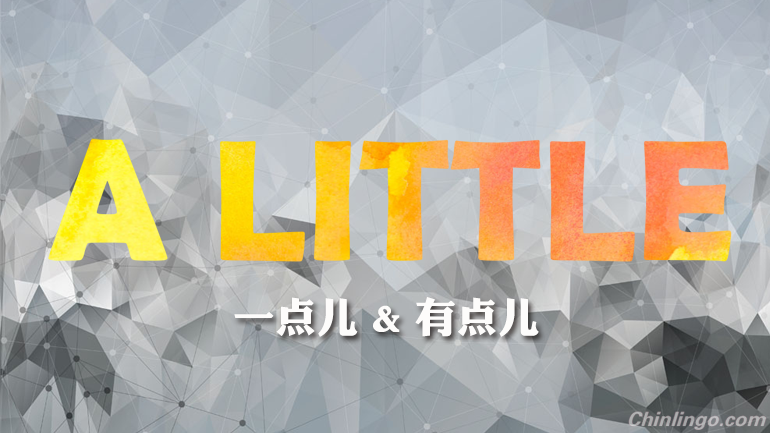
In Chinese, both "一点儿 (yī diǎn ér)" and "有点儿 (yǒu diǎn ér)" indicate an indefinite small quantity. "一点儿 (yī diǎn ér)" can not only be used after a stative verb or adjective, but also before a noun or used alone. "有点儿 (yǒu diǎn ér)" can only be used before a stative verb or adjective, and it can't be put before a noun. For example:
"一点儿"和"有点儿"在中文里都表示不定的较少的数量。"一点儿"除了用于状态动词或形容词后以外,还可以单独用或放在名词前。而"有点儿"只能放在状态动词或形容词前,不能用在名词前。例如:
每天晚上喝一点儿葡萄酒有助于睡眠。
měi tiān wǎn shàng hē yī diǎn ér pú táo jiǔ yǒu zhù yú shuì mián.
Drinking a little wine every night helps you sleep well.
In addition, the structure will change if these two phrases are put in different positions in a sentence.
另外,这两个短语在句中的位置不同,构成的常用结构也不同。
The common structure of "一点儿"
"一点儿"的常用结构
"一点儿 (yī diǎn ér)" can be used in comparative sentence with the structure "A比B+adjective+一点儿". For example:
"一点儿"可用于比较句中,构成"A比B+形容词+一点儿"的格式。例如:
这种中药比那种苦一点儿。
zhè zhǒng zhōng yào bǐ nà zhǒng kǔ yī diǎn ér.
This kind of Chinese medicine tastes a little more bitter then that one.
"一点儿 (yī diǎn ér)" can also be used after a verb, with the structure "verb+一点儿". For example:
"一点儿"可用在动词后,构成"动词+一点儿"的格式。例如:
别客气,多吃一点儿。
bié kè qì ,duō chī yī diǎn ér.
Be my guest! Eat a little more.
喝一点儿吧,这果汁味道不错。
hē yī diǎn ér ba ,zhè guǒ zhī wèi dào bú cuò.
This juice tastes good, please drink some more.
"一点儿 (yī diǎn ér)" can be used both as an adverbial modifier before an adjective or stative verb. For example:
"一点儿"还可以重叠后放在形容词或状态动词前作状语。例如:
你别急呀,听我一点儿一点儿地给你介绍。
nǐ bié jí ya ,tīng wǒ yī diǎn ér yī diǎn ér de gěi nǐ jiè shào.
Take it easy. Listen, I will introduce it to you bit by bit.
可怕的沙漠一点儿一点儿地蚕食着我们的土地。
kě pà de shā mò yī diǎn ér yī diǎn ér de cán shí zhe wǒ men de tǔ dì.
The horrible desert is gradually nibbling at our land.
Followed by "不 (bù)" or "没 (méi)", "一点儿 (yī diǎn ér)" can describe an adjective or negative form of a verb. The structure is "一点儿+都/也+不/没+adjective or verb". Note that the "儿 (ér)" in this structure can be omitted. For example:
"一点儿"可以用在"不/没"的前面,修饰形容词或动词的否定式,构成"一点(儿)+都/也+不/没+形容词/动词"的格式。注意这个结构里的"儿"字可以省略。例如:
你一点(儿)都不笨。
nǐ yī diǎn ér dōu bú bèn.
You are not stupid at all.
他来广州已经好几年了,可广东话一点(儿)也没学会。
tā lái guǎng zhōu yǐ jīng hǎo jǐ nián le ,kě guǎng dōng huà yī diǎn ér yě méi xué huì.
He has stayed in Guangzhou for several years, but learned almost no Cantonese.
The common structure of "有点儿"
"有点儿"的常用结构
Generally, "有点儿 (yǒu diǎn ér)" should be put before an adjective or stative verb as an adverbial modifier, indicating a feeling of dissatisfaction. Again, you can leave out the "儿 (ér)" in this kind of sentences. The structure is "有点儿+adjective or verb". For example:
"有点儿"通常要放在形容词或状态动词前,直接作状语,构成"有点儿+形容词/动词"的结构,多表示不满意。同样,这类句型你也可以省略"儿"字。例如:
这个桌子的颜色有点儿浅。
zhè gè zhuō zi de yán sè yǒu diǎn ér qiǎn.
The color of this desk is a little light.
对于这件事,他有点儿后悔。
duì yú zhè jiàn shì, tā yǒu diǎn ér hòu huǐ.
He feels a little bit regretful about this.
他觉得上海菜有点儿甜,感到有点儿不习惯。
tā jué de shàng hǎi cài yǒu diǎn ér tián, gǎn dào yǒu diǎn ér bù xí guàn.
He thinks Shanghai food tastes a bit of sweet, and he finds it a little difficult to get used to.



 闽公网安备 35020302035673号
闽公网安备 35020302035673号
0 responses on "Differences between Chinese words "一点儿" and "有点儿""